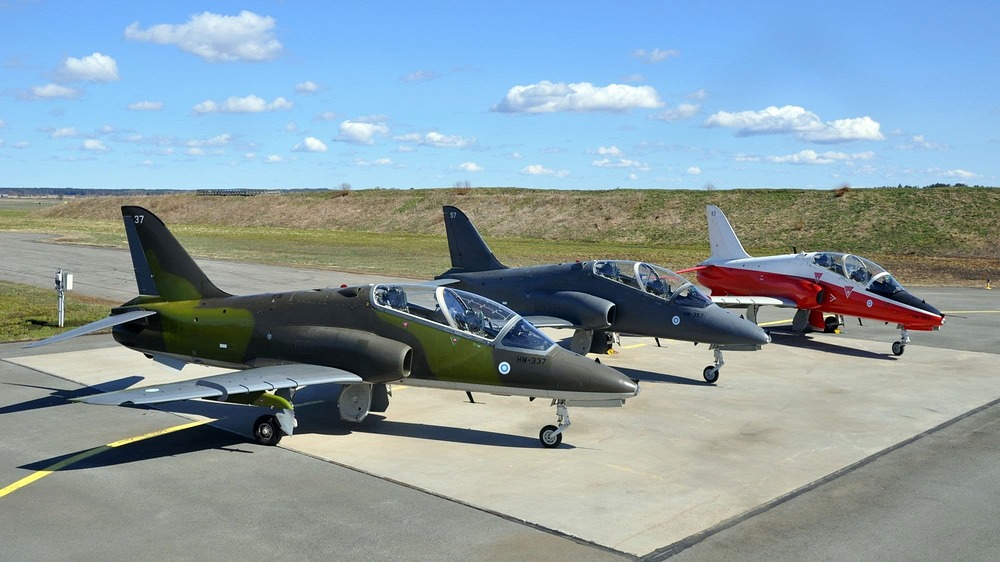- Yes
- No
Introduction: The BAE Hawk represents one of the biggest success stories of postwar British aviation, being sold in various guises all over the world, serving as the reliable workhorse of various air forces.

Background: The first whispers of a new jet trainer were heard in the late 1960’s. The Jaguar T.2 had recently entered service, but it was found to be too complicated and expensive in its role as a replacement for the Hunter T.7 and Gnat T.1 in RAF service. An additional problem was the fact that there was too large of a gap between its performance and that of the Jet Provost, which ultimately showed that there was still a need for an intermediary jet trainer between the two types. Both BAC and Hawker Siddeley had begun private studies already by this point, in order to study the market, but in 1970, an official requirement was issued. The RAF only needed around 150 aircraft, so emphasis was placed on securing export orders. The aircraft was to be used in for pilot training at low, medium and high altitudes in day and night, instrument flight training, formation flying, navigation and weapons training. The maximum speed would be about Mach 0.84, with an optimum cruising speed of Mach 0.60 at 36,000ft, with a climb of seven minutes to reach that altitude. Overall configuration of wings, components and pilot arrangements was left up to the manufacturer.

Development: Hawker Siddeley had foreseen the need for a new trainer, and had been studying the market accordingly. They worried that the market that the UK had built up to that point with the Vampire, Hunter and Jet Provost/Strikemaster would be lost to competitors. They also foresaw the need to replace the in-service types of the time, with jet trainers such as the Magister, Jet Provost and T-37 soon likely to begin suffering from obsolescence. There was also the additional need to replace piston-engine types with a new aircraft as well. Hawker Siddeley saw that there was a market for about 6000 aircraft, with a goal to capture at least 600 orders. Initial designs were quite conservative, eschewing advanced performance and aerodynamics in order to lower development risk and cost. By the time the HS.1182 program was formally concluding, over twenty different design configurations were studied before a final design was to be agreed upon. The HS.1182 went against the BAC P.59 in the competition and won. Originally known as Tercel, the name was soon changed to Hawk.

Service: The first Hawk flew in August 1974, with testing occurring soon afterwards. Testing revealed some issues, but these were corrected quickly and overall, things ran smoothly. By 1976, the first Hawks began entering service, with the program, running ahead of schedule and under budget. The T.1As were used for weapons training, carrying a 30mm ADEN cannon pod. Although the RAF did not see an initial combat role for the Hawk, they were outfitted for emergency use. Initially, this was for ground-attack use against Soviet armoured columns. Aircraft from the Weapons Training Units would be flown by the instructors to Germany, and be taken up as part of the defence of NATO territory against the Warsaw Pact armoured onslaught. These missions would usually be undertaken with loadouts containing a 30mm ADEN, SNEB rockets or BL.755 cluster bombs. Their emergency role was soon extended to that of air defence, in which they would be paired with Tornado F.3s. To do this, they were armed with a pair of AIM-9Ls. The Hawks would serve well with the RAF for the next few decades, with all fast jet pilots having flown on one at some point or another. Arguable their most famous role is in their role with the Red Arrows. After 45 years of service, the type was withdrawn from use in 2021.
Performance:
Spoiler
HAWK T1/1A Specifications
Crew 2
Span 9.39m
Height 3.99m
Length 11.96m
Weight Empty 3,647kg
Max Take Off Weight 8,569kg
Combat Radius 556 km/345 miles
Max Speed 622mph/1,000kph at sea level
Engine 1 x Rolls Royce/Turbomeca Adour Mk 151 turbofan
Armament (T1) 1 x 30mm Aden cannon pack
Up to 5,600lb/2,540kg of under-wing stores for rockets, bombs and missiles
Armament (T1A) In addition has inboard pylons for Sidewinder AIM-9 AAM.
Conclusion: I believe that the Hawk would make for an interesting vehicle in the tech tree between the Hunter F.6 and Phantom FGR.2, combining good ground attack and air-to-air capabilities with a highly agile platform. In this scenario, it would be preferable that the SRAAMs would be removed from the Hunter F.6 so that it can go down in BR, with the Hawk T.1A taking its place.
Sources:
Spoiler
BAE Hawk T.1A:
“Teach for the Sky: British Training Aircraft since 1945” by James Jackson
Royal Air Force Information - RAF Aircraft - Hawk T1/T1A - Hawk T2 (128) - r7a7 - Armed Forces
“Teach for the Sky: British Training Aircraft since 1945” by James Jackson
https://www.forces.net/news/hawk-t1-and-t2-all-you-need-know
Images:
File:British Aerospace Hawk T1A, UK - Air Force AN1801301.jpg - Wikipedia
https://www.airforce-technology.com/projects/hawk/
https://www.reddit.com/r/Warthunder/comments/ghm6o8/gaijin_please_bae_hawk_t1a_trainer_converted_to/

